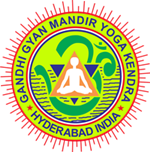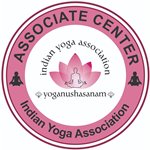Asanas practiced in sitting position require only a small place. A clean cloth is spread and they are practiced according to one’s capacity. There are many asanas that are practiced in sitting position. The practitioners are advised to perform the asanas in the order they are described below for better results.
- 1. Nispand bhavasan
- 2. Utkut Pavan muktasan
- 3. Paschimottanasan
- 4. Vistrut Padahastasan or Bhoonamanasan
- 5. Aakarn Pad-hastasan
- 6. Bhadrasan
- 7. Pakshi Kriya
- 8. Gorakshasan
- 9. Merudandasan (A set of various asanas)
- 10. Janu-shirasan
- 11. Vajrasan
- 12. Shashankasan
- 13. Ushtrasan
- 14. Supta Vajrasan
- 15. Marjarasan
- 16. Tripadasan
- 17. Vakrasan
- 18. Matsyendrasan or Ardha Matsyendrasan
- 19. Gomukhasan
- 20. Pad-chalan Kriya
- 21. Chakki chalan Kriya
- 22. Padottanasan or Uttanapadasan
- 23. Poorvottanasan
- 24. Nabhi darshanasan
- 25. Sukhasan
- 26. Siddhasan
- 27. Padmasan
- 28. Yogamudrasan
- 29. Parvatasan
- 30. Tulasan, Dolasan or Jhulasan
- 31. Padma-konasan
- 32. Padma chakrasan
- 33. Kukkutasan
- 34. Garbhasan
- 35. Baddha Padmasan
- 36. Matsyasan
- 37. Bakasan
- 38. Padangushthasan
- 39. Aakarna Dhanurasan
- 40. Koormasan
- 41. Simhasan
- 42. Mayurasan
- 43. Mayuri asan
1. Nispand bhavasan:
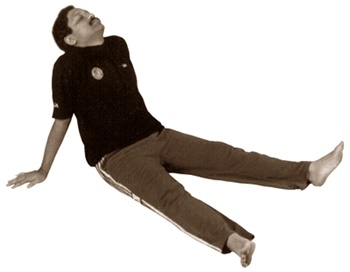
There should be no response from the mind to any stimulation (=spandan) in this asan. All the thoughts are given up while exercising this asan, so it got its name.
Procedure:
Spread the legs 10 to 18 inches apart in the sitting position and let them loose. Place both the hands on the floor behind the back. Keep the head raised and breathe slowly.
The mind is moved on the entire body and all the parts of the body are let loose. If hands start paining, lean back against the wall and practice.
Awareness:
Relaxation of the body
Advantages:
This asan provides rest to the body as the Shanti Asan does.
Note: While practicing the following asanas, whenever you feel tired, you may rest in this posture.
“Nispand bhavasan gives rest to body and mind”
2. Utkut Pavan muktasan:
This sitting asan releases the unwanted air from the body, so it is called Utkut (=sitting) Pavan muktasan.
Procedure:
1. Sitting on the floor, stretch both the legs and join the heels. Fold the right knee and hold with both hands. Press the stomach with the right thigh. Breathing out, lower the head and rest the chin on the knee. Breathing in, stretch the right leg straight.
2. Similarly, repeat the action with the left leg.
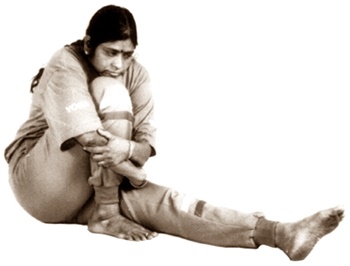
3. After practicing this asan separately with each leg, fold both the legs together and hold with both hands. Press the stomach with both the thighs and try to place the chin between the two knees, breathing out.
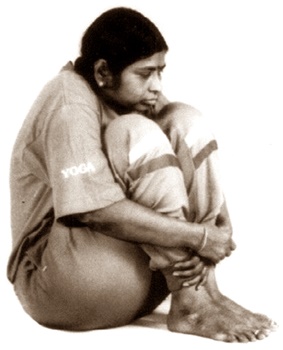
The above three form a round. Like this, 3 to 4 rounds should be practiced.
Persons of any age or any state can practice it before taking breakfast or 4 to 5 hours after taking meals.
Awareness:
Stomach
Advantages:
Knee pains, gastric trouble, acidity, indigestion, constipation and pot bellies are reduced by practicing this asan.
“Utkut Pavan-muktasan releases the unwanted gases”
3. Paschimottanasan:
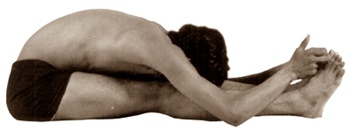
Paschim means back, tan means stretching. The back is stretched in this asan.
Procedure:
While practicing the following steps, breathe out whenever the body is bent and breathe in whenever the body is brought to the normal straight position.
1. Stretch both the legs and keep the upper part of the body swinging backwards and forwards. While swinging, touch the knees, calves, ankles and toes with the fingers, gradually step by step one after the other, as one proceeds.
2. Sitting on the floor, stretch both the legs, placing hands on the knees.
3. Keeping the body as in 2 above, bend further to touch the toes.
4. Keeping the body as in 3 above, holding the toes with fingers, try to place both the elbows at the side of the knees. Touch the knees either with forehead or the nose.
Back should be strong enough either to stand for a long time or to walk a long distance. For that, the above steps are to be practiced gradually one after the other and tried to reach the fourth position of this asan.
Awareness:
Back and Backbone
Advantages:
The back is strengthened by doing so. Obesity is reduced. The backbone becomes active and always is alert.Menstruation cycle is regularized.
Note: It is a difficult asan for many. People with pot bellies and who cannot bend their backbones have to practice this asan slowly without any hurry and with great care.
“Paschimottanasan empowers the back”
4. Vistrut Padahastasan or Bhoonamanasan:

Both the legs are stretched apart (=Vistrut) to their maximum and the feet (=pad) are caught by the hands (=hasta) so it is called Vistrut Padahastasan. Head bows (naman) to the earth (bhoo) and so it is also called Bhoonamanasan.
Procedure:
Sitting on the floor, stretch both the legs slowly apart to their maximum. Raise both the hands. Bend forward and touch the toes with fingers breathing out. Try to place the head on the floor. Repeat 5 to 6 times.
Awareness:
Calf muscles / back
Advantages:
Calf muscles, thighs, waist and the back are strengthened. Pot belly is decreased.
“Vistrut Padahastasan strengthens the calves”
5. Aakarn Pad-hastasan:
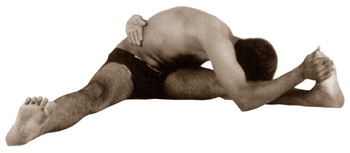
One foot (pad) is touched with the other hand (hasta) and the ear (karn) is placed on the knee. So it is called Aakarna Padahastasan.
Procedure:
Sitting on the floor stretch both the legs apart to their maximum and touch the left foot with right hand and place the right ear on the left knee breathing out, left hand touching the back.
Similarly repeat it on the other side and alternatively do it for 10 to 12 times.
Awareness:
Waist
Advantages:
Back, backbone, waist, neck and legs are strengthened and activated. Pains are relieved.
“Aakarn Pad-hastasan makes the waist supple“
6. Bhadrasan:
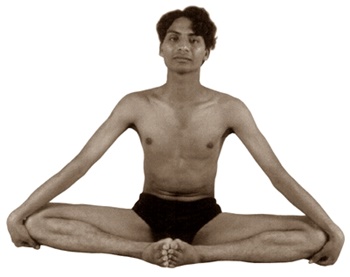
Grace (Bhadra) has been given prominence in this asan, so it is called Bhadrasan.
Procedure:
Sitting on the floor, spread both the legs. Join both the soles and bring the heels near the groin. Press both the knees to the floor with both the hands. Breath normally with closed eyes. After a while stretch the legs straight, and relax.
Awareness:
The place between the anus and reproductive organs i.e. prime seat
Advantages:
Thighs, knees and calves are energised. Problmes of reproductive organs are controlled. Mind feels peace, safety and tranquility.
“Bhadrasan makes you soft”
7. Pakshi Kriya:
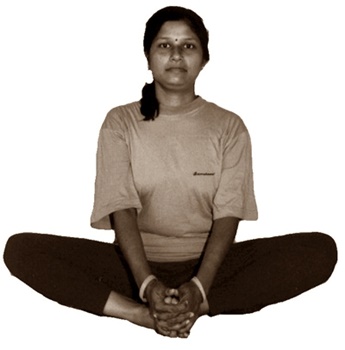
Knees are moved like the wings of a bird (Pakshi) in this action. So it is called Pakshi kriya.
Procedure:
Sitting on the floor stretch both the legs straight. Later fold both the knees and join the soles to form the Namaskar shape. Bring the heels very close to the reproductive organ, rather they touch it as in Bhadrasan. Interlocking the fingers of both the hands, hold the feet.
Move both the knees up and down like the movement of the wings of a flying bird for some time. Later stretch the legs straight and relax. Breathing is normal. Repeat 2 to 3 times.
Awareness:
Thigh joints
Advantages:
Pains in knees, thighs, leg pits and thigh joints are relieved. The entire body is felt light. Every one can comfortably practice this activity.
“Pakshi Kriya makes the body feel light”
8. Gorakshasan:
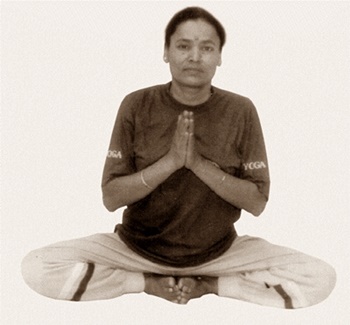
This asan is named after Guru Gorakhnath who practiced it more.
Procedure:
As in Bhadrasan, both the soles are joined together and are placed touching the thigh joints. Pressing the floor with both the palms, raise the buttocks and place them on the heels. After gaining full balance, lift the hands from the floor and place on the knees. After being in that position for some time, join both the palms before the chest or over the head in the Namaskar posture. Breathing is normal.
Awareness:
Reproductive organs
Advantages:
Glands in the reproductive organs are strengthened and semen is safely protected. Urinary problems are solved. Menstrual problems are controlled. Back pain is gradually relieved.
Prohibition:
People with excess fat in the body and people with heart problems are advised to practice this asan with great care.
“Gorakshasan empowers the glands in the reproductive organs”
9. Merudandasan (A set of various asanas):
Merudandasan has been dealt in the chapter 12 – “Asanas practiced in the lying position”. This is also a set of important and easy asanas among the asanas practiced in the sitting position.
Merudand means back bone. This asan makes the backbone supple, active and strong. The different activities concerned with this asan are explained below.
Every following activity is to be practiced bending / twisting the parts of the body once towards right and then towards left slowly 5 to 10 times. Breathe out while twisting the body and breathe in while coming to the normal central position.
Procedure:
1. Stretch both the legs straight and join the heels. Place both the palms on the floor on right side. Bending downward place the forehead and the chest on the floor. After few seconds repeat on other side.
Awareness:
Backbone – Upper part and neck
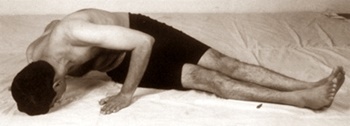
2. Stretch both the legs forward. Place both the hands on the floor at the backside. Join both the heels. Turn rightwards and head to the left. After some time come to central normal position. Repeat on other side.
Awareness:
Backbone – Upper part.
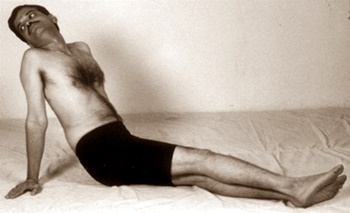
3. a. Place both the hands on the floor at the back. Stretching both the legs straight, place right foot across on the left foot. Twisting the waist towards right, turn the head to left. After some time come to the normal position. Repeat on otherside.
b. Placing the left foot across on the right foot, practice as in 3a.
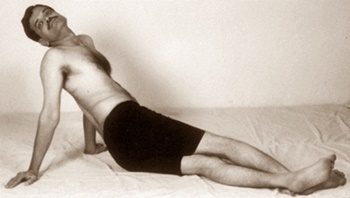
4. a. Place the right heel on the left toes and follow the procedure of 3a on two sides.
b. Place left heel on the right toes and repeat as in 4a.
Awareness:
Backbone – Lower part
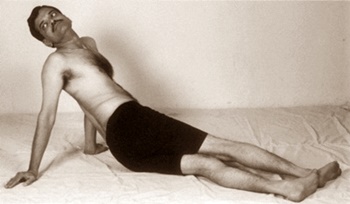
5. a. Place the right sole on the left knee. Place both the hands on the floor. Turn the right knee to touch the ground on the left side. Again turn it to right to touch the floor.
b. Place the left sole on the right knee and repeat the process of 5a.
Awareness:
Waist
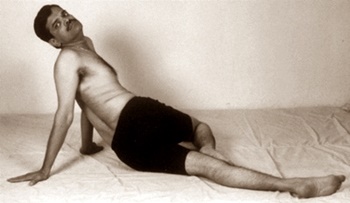
6. Place both the palms on the floor. Fold the legs and bring the heels near to the hips. Turn both the legs together to right side touching the floor, looking at the left over the left shoulder. Similarly turn the legs together left and look right.
Awareness:
Lower back
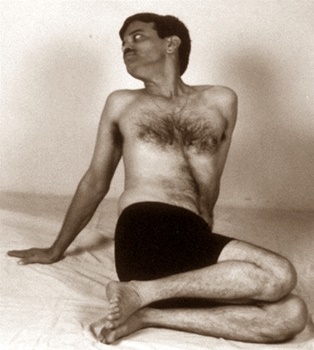
7. As in No.6, join the knees, then bent the left knee towards left and right knee towards right. Both the soles are joined together. Now swing both the knees up and down for some time.
Awareness:
Thigh joints

8. Place both the palms on the floor. Fold the legs and bring the heels near as in No.6. Raise the body from the hips, so that the knees touch the floor. Bend the head back. The weight of the body should be on palms, toes and knees.
Awareness:
Toes
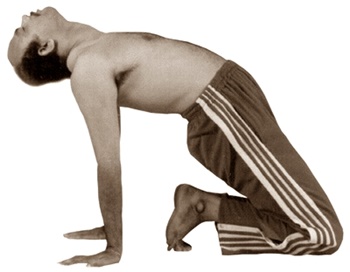
9. As in No.8, join the knees and raise the hips. The weight of the body should be on palms and feet. Move slowly the knees together in a circular form clockwise for 5 to 6 times and then move anticlockwise.
Awareness:
Waist / toes
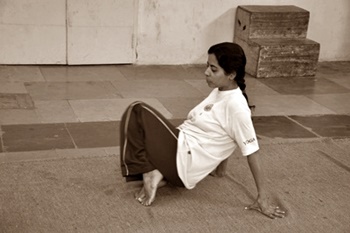
10. Place both the palms at the back. Place both the knees and heels one foot apart. Bring both the heels near the buttocks. Bend both the knees towards right and try to place them on the floor, turning the head towards left. Left knee should touch the right sole. Then repeat on the other side.
Awareness:
Thighs / waist
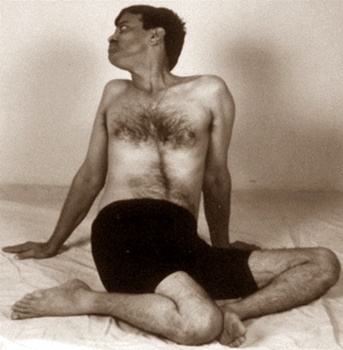
11. Stretch both the legs straight. Place the palms on the floor at the back. Raise the right leg without bending the knee, and turn it over the left leg and place it on the floor. Turn the head right. Similarly practice it with other leg.
Awareness:
Waist / thigh joints
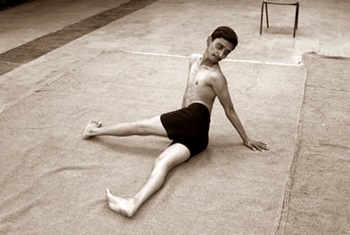
12. Stretch both the legs straight and join together. Place palms at the back. Raise both the legs together and place them over to the right side, turning the head to left. Similarly do it on the other side.
Awareness:
Lower back
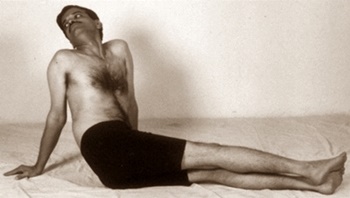
Note: In all the above, the body should remain in the final posture for 4 to 5 seconds. If hands are felt tired during the above exercises, they may be stretched sidewise and the arms may loosely be moved side to side to relax. Later each hand is massaged with the other one. After relaxing the hands in this way, one may proceed for the next exercise.
Advantages:
This set of asanas benefits the entire body. Back and backbone become flexible, active and supple. Obesity is controlled. Stomach, liver, pancreas, kidneys, spleen, intestines are purified, strengthened and their diseases are prevented and controlled. Intestines are cleaned. Limbs become strong. Actually this set should be done daily for its multi-purpose benefits.
“Merudandasan increases the flexibility of the backbone”
10. Janu-shirasan:
Head (=Shir) touches the knees (=Janu) in this asan. So it is called Janushirasan. This asan indicates the existing health condition and flexibility of the back bone.
Procedure:
a. Stretch both the legs straight. Let the right sole touch the left thigh. Move the right heel further and place it touching under the urinary organ. Raise both the hands and interlock the thumbs. Breathing out, bend the chest and the head slowly down so that the forehead touches the left knee and fingers touch the toes. Breathing in, raise the hands and bring the body to the upper normal position. Repeat it 5 to 6 times. Later change the legs and repeat the exercise.
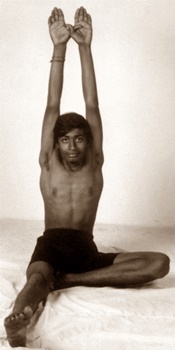
b. Stretch both the legs straight. Place the left heel on the right thigh. Hold the right toes with the right hand. Bring the left hand from behind and catch the left toes that are placed on the right thigh. Breathing out, slowly bend the fore head so low that it touches the right knee. Breathing in, raise the head to normal position. Repeat it 5 to 6 times. Later change the legs and repeat the exercise.
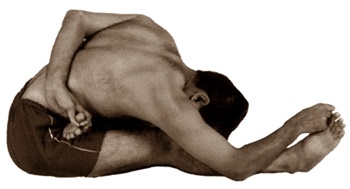
Awareness:
Backbone
Advantages:
This exercise sets right the inner organs such as liver, pancreas, spleen and helps the intestines function properly. The joints and the nerves connected with the backbone are strenghened. Digestive power is increased.
Prohibition:
Women during their menstrual period and pregnancy should not attempt this asan. People suffering from back pain are advised not to attempt this asan till they are relieved of the pain. After they get rid of the pain, they can do this asan.
“Janu – shirasan tests the strength and the flexibility of the backbone”
11. Vajrasan:
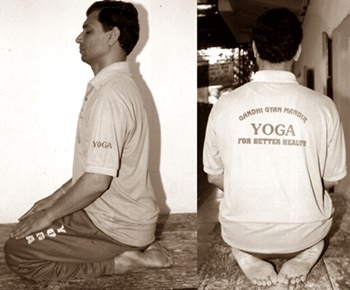
This is one of the most important four asanas. This asan influences the Vajranadi, which is connected with genital and urinary organ.
Procedure:
Stretch both the legs straight. Bend both the knees one after the other and place the feet under the buttocks. Keep the heels apart while big toes touch each other. Place the palms on the knees. Keep the head and the back straight and erect but without any stiffness. Be in this posture with normal breathing for some time with eyes closed and then straighten the legs and relax.
In the initial stage it may be practiced by sitting on alternately, one foot (i.e. Ardha Vajrasan) and later on both the feet.
Awareness:
Breath
Advantages:
It strengthens thighs, knees and calves. This asan also helps as an initial stage for meditation.
Sitting in this asan after meals for 5 to 20 minutes benefits a lot. It prevents constipation, hyperacidity, piles, hernia, indigestion. Sciatica pains are relieved. Calf muscles, knees and thighs are strengthened. This asan helps in improving digestion. This is the only asan that is practiced after taking the meals. It helps to expecting mothers to deliver the child with ease.
People suffering from knee pain can try to do it in sitting on a soft cushion in the beginning. They may keep this cushion between the buttocks and the heels.
Prohibition:
People suffering with severe Arthritis and Rheumatism in knees should not attempt till their problem is solved.
Note: Knowing the benefits of this asan, people of all religions practise it. During Namaz, Muslims pray in this asan so it is also called Namaz Asan.
“Vajrasan increases the digestive power”
12. Shashankasan:
This asan is postured in the pose of a sitting rabbit (=Shashank). So it got its name.
Procedure:
Repeat each of the following steps 3 to 4 times. Everytime breathe out while bending forward and breathe in while coming up. In all the following, only hands positions are different.
1. Sitting in Vajrasan, take both the hands to the back and hold one wrist with the other hand. Slowly bend forward so low that the forehead touches the floor. Don’t raise the hips from upon the heels. After few seconds come back to Vajrasan.
Awareness:
(Inside) the head
2. Place the fists on the either side of the navel and practice as in No. 1 above.
Awareness:
Navel / abdomen
3. Stretch both the hands upwards, and practice as in No.1, palms touching the floor in final position.
Awareness:
Arms
4. Stretch both the hands side wise and practice as in No.1, palms touching the floor on both sides.
Awareness:
Chest
5. Interlock the fingers and place them on the neck and practise as in No. 1 in such a way that the elbows touch the knees.
Awareness:
Back of the neck
6. Place both the hands on the back interlocking fingers other hand. Practice as in No. 1 raising the hands straight up from behind.
Awareness:
Waist
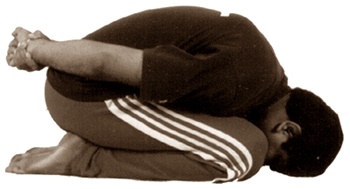
Advantages:
All the benefits of Pavan muktasan and Vajrasan are derived from Shashankasan. Diabetes is controlled. The pains of waist and neck are reduced. This asan reduces the intensity and the frequency of anger in those, who frequently lose their temper. The Sadhak even if he becomes angry, his anger is controlled quickly and he becomes calm.
“Shashankasan reduces anger”
13. Ushtrasan:
The body becomes like the shape of a camel (=Ushtra) during this asan. So it is called Ushtrasan. This was one of the asanas practiced by Indian astronauts in the space.
Procedure:
1. Posturing Vajrasana place the hands on the waist. Breathing in resting the knees on the floor, raise thighs and hips and look up. Keep some distance between the knees and between the feet. Breathing in come to normal position. Repeat it 4 to 5 times. This is the first stage towards Ushtrasan.
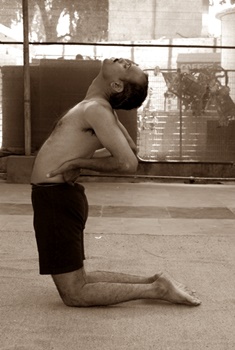
2. From Vajrasan, as in No. 1 above, raise the thighs, hips and both the hands and look upwards. This is the second stage.
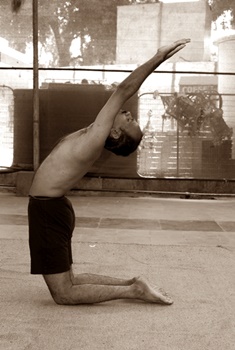
3. Being in the Vajrasan sit on the toes. Hold both the heels with the fingers. Taking deep breath raise thighs, hips, abdomen and chest fully. The head and backbone will bend backwards. Breathing out, come back to down position. Repeat 4 to 5 times.
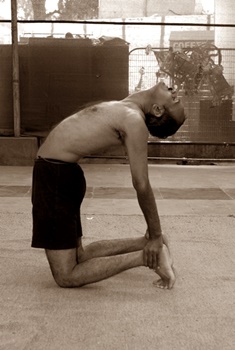
Awareness:
Chest, lungs, heart
Note: It is very essential to maintain the balance of the body, while raising up, resting the entire weight of the body only on the knees. If not, one is sure to fall due to imbalance.
Advantages:
Lungs can be fully expanded in this asan. It works very well for the people suffering from chest, lungs or heart diseases. It slims the fat body. Back bone is made active and flexible. Digestive power increases. It strengthens knees, thighs, waist, back, shoulders and neck. It empowers all the inner organs of the body.
“Ushtrasan purifies and strengthens the chest”
14. Supta Vajrasan:
Lying down in the Vajrasan is called Supta Vajrasan.
Procedure:
1. From Vajrasan, place palms adjacent to heels on the floor. Try to place the elbows on the floor one after the other. Later, try to place the top of the head on the floor. Now place the hands on thighs or join the palms before the chest in Namaskar position. Breath is normal. Be in this posture for 5 seconds to 2 minutes. Then place back the elbows on the floor. Pressing the elbows raise the body and come back to Vajrasan . Repeat 2 to 3 times.
It should be tried to bend the body slowly backward in the initial stage. Later it can be done easily in a few days. After doing it easily, the following exercise may be taken up as the second stage.
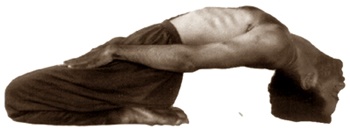
2. Sitting in Vajrasana, ask some one to hold your knees firmly. Then fold both the hands before the chest holding the elbows (like yours most obediently). Being in this stage repeat Supta-Vajrasan Kriya 4 to 5 times. Breathe in while bending back, breathe out after bending low. Again breathe in as you come up to Vajrasan.
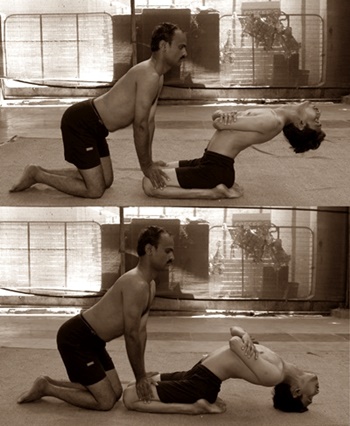
Awareness:
Thighs / back / neck
Note: In the initial stage, if anyone cannot bend back the head completely to the floor, 3 to 4 pillows may be piled to raise the floor at the back to rest the head on them. Later on each pillow may gradually be reduced everyday and practice the asan, so that the head may gradually be bent backward completely and rested on the floor directly.
Advantages:
This asan stimulates the organs of the stomach and the neck muscles. It increases the power of functioning of lungs. Bronchitis and asthma are conrolled. Waist, thighs, calf muscles and heels are energized and they become shapy. If two glasses of warm water is drunk before practicing this asan, one can conveniently get rid of the constipation problem.
Precaution:
This being a difficult asan, one should not hurry but practice gradually and slowly. People suffering from pains in knees and waist are advised to practice this asan, when they are relieved of the pains completely. They may initially practice it keeping the legs straight instead of Vajrasan.
“Supta Vajrasan energizes waist, thighs and the calf muscles”
15. Marjarasan:
Marjar means a cat. In this asan, the body is postured like a sitting cat, so it got its name.
Procedure:
1. Sit in Vajrasan raising the thighs stand on knees. Bending the body forward place both the palms on the floor. Now raise the backbone and lower the head breathing out.
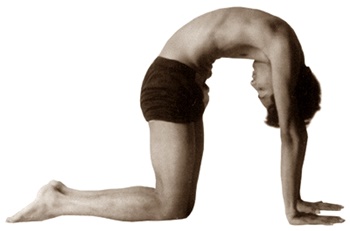
2. In the second stage lower the backbone. Looking up breathe in. Practice these two activities smoothly 5 to 6 times one after the other.
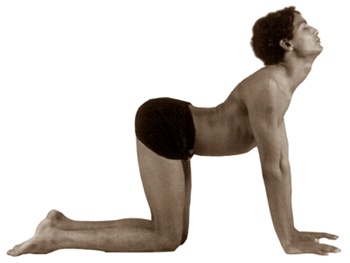
3. After the above practice, now with head upwards and backbone down, look backwards over your right shoulder and then left shoulder. Repeat 5 to 6 times.
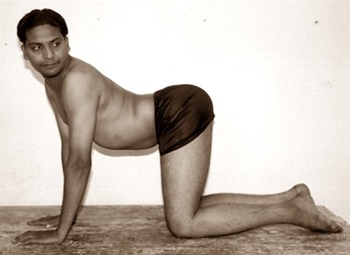
Awareness:
Backbone
Advantages:
Back and waist pain is relieved. Each vertibre of spinal column is stimulated. The excess fat in the hips and stomach is reduced.
“Marjarasan makes the backbone flexible”
16. Tripadasan:
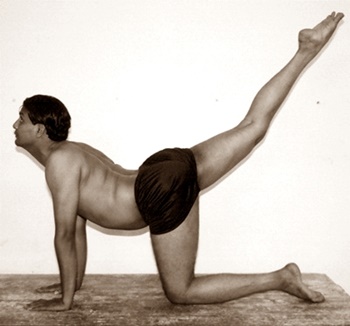
This is an extension of Marjarasan. The body rests on 2 hands and 1 leg, so this name was suggested.
Procedure:
From Marjarasan (position2), keeping backbone lowered and head raised upwards, stretch back the right leg lifting to maximum, breathing in. After few second come down to normal Marjarasan. Repeat the same with left leg. Alternatively perform 5-6 times.
Awareness:
Lower back and the lifted leg
Advantages:
Apart from all the benefits of Marjarasan, the nerves of legs are empowered. Sciatica pain is relieved. Balance of mind is achieved.
“Tripadasan for strong back and legs”
17. Vakrasan:
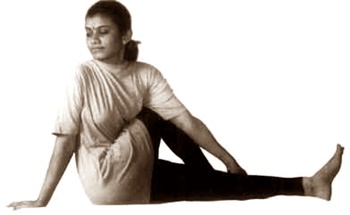
The body is in the twisted (=vakra) position in this asan. So it is called Vakrasan.
Procedure:
Stretch both the legs forward. Raise the right foot and place it across the left knee. Place the right palm on the right side on the floor, the fingers pointing backward. Raise the left hand and take it over the right knee and hold the right toes. If it is not possible, the right knee may be held.
Breathing out, turn the waist and right shoulder rightwards and look back over the right shoulder. The entire backbone is twisted. Breathing in bring the body back to the normal position. Repeat it 5 to 6 times.
Later change the legs and hands, practice in reverse turning left.
Awareness:
Backbone and waist
Advantages:
Back, neck and backbone problems are cured. The internal organs of the stomach are energized. This helps in controlling diabetes and obesity.
This is the earlier stage of Matsyendrasan.
“Vakrasan a simple asan that energizes the central organs of the body”
18. Matsyendrasan or Ardha Matsyendrasan:
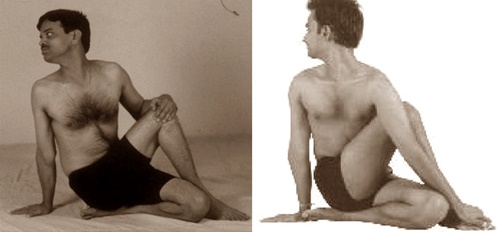
Mahayogi Matsyendranath used to do this asan more prominently so it got his name. Posturing Ardha- Matsyendrasan is easy.
Procedure:
Be in Vajrasan. Release the right foot and place it standing across the left knee. Place the right palm at the right side of the body with the fingers pointing back. Raise the left hand and crossing the right knee hold the right toes. If it is not possible, hold the right knee. Breathing out, turn the waist and shoulders rightwards. Turn the head also to maximum right and look back. The entire back should be turned as in Vakrasan. Breathing in come back to normal position. After repeating 5 to 6 times, change the hands and legs and repeat 5 to 6 times towards left.
If any one can practice Vakrasan perfectly, he can do the above Ardha-Matsyendrasan conveniently.
Awareness:
Backbone, waist, abdomen especially on pancreas
Advantages:
Backbone, back and muscles are strengthened. Ribs and chest get energized. The working efficiency of backbone and nervous system increases. The fat in the waist is reduced. Diabetes is brought under control with this asan, as it activates the pancreas intensively. Constipation is reduced and appetite is increased. This multi-purpose asan can be said as the eradicator of all the diseases (Sarva-rog nivarini).
“Matsyendrasan to prevent diabetes”
19. Gomukhasan:
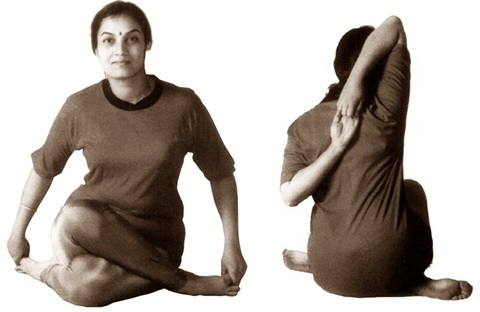
In this asan, knees form the shape of the jaws of cow so it got its name.
Procedure:
Sitting in Vajrasan, release the right leg and bring it over the left leg in such a way that the right knee is placed over the left knee. Raise the right hand up and bend back downwards, then fold the left hand from back upwards. Try to catch the right fingers with left fingers at the center of the back. Breathing out, bend forward so that the chin touches the right knee. Breathing in come upwards. Repeat 4 to 5 times and then practice the same changing legs and hands.
Note: If it is difficult to bring both the hands together at the center of the back, a handkerchief may be used between them and gradually the kerchief may be taken in from both the hands, ultimately bringing the hands together.
If hands cannot be raised and brought to the back, initially, the toes may be held and the exercise practiced.
Awareness:
Various joints (one at a time) especially, painful joint if any
Advantages:
It is very useful to stimulate the organs and muscles of the stomach and the backbone. Glands become active. Pains in the neck are relieved. This asan helps in controlling diabetes, excess urination, blood pressure and hernia. This also reduces the weakness of the reproductive organs. The pains in the different joints of the body, particularly the joints in the limbs (hands and legs) are reduced and relieved.
“Gomukhasan relieves the pains in the joints”
20. Pad-chalan Kriya:
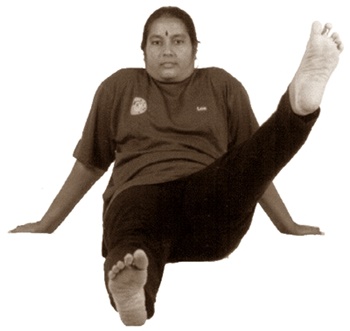
The movement of the leg is prominent in this asan, so it got its name.
Procedure:
Stretch both the legs and keep the palms at the sides on the floor.
1. Raise the right leg straight up and rotate it clockwise to form big circles 6 to 8 times. Then perform it anticlockwise also. Breathing is normal.
2. Perform the above procedure raising the left leg.
3. Similarly do it with both legs simultaneously together in the circular clockwise and anti-clockwise directions.
Awareness:
Thighs and thigh-joints
Advantages:
Thigh joints are strengthened. Nerves and muscles of the legs are energized.
“Pad-chalan Kriya strengthens the thigh joints”
21. Chakki chalan Kriya:
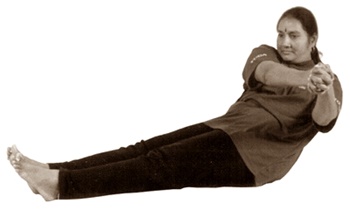
Chakki means a traditional type of a manual grinder, carved in stone to flour the grain. Hands are moved in this asan, as they are moved while operating the Chakki. Hence this asan is called Chakki chalan Kriya.
Procedure:
1. Stretch both the legs together straight in the sitting position. Stretch both the hands straight, join the palms and interlock the finger. Rotate the hands in clock-wise direction forming big circles i.e., from front to right, right to chest, chest to left and left to front continuously 8 to 10 rounds. When the hands come to the chest, the body bends backwards breathing in, while bending forward try to touch the toes breathing out. Repeat anti-clockwise circles also.
2. Keeping the legs straight, raise the hands up and interlock the fingers. Now rotate the hands clockwise without bending the elbows, try to touch the toes breathing out. Repeat 6 to 8 times. Then also perform anti-clockwise.
Awareness:
Movement of the arms
Advantages:
Pot belly is reduced. The chest and the thighs are strengthened. Digestive power is increased. Gastric trouble is controlled.
“Chakki chalan Kriya increases the digestive power”
22. Padottanasan or Uttanapadasan:
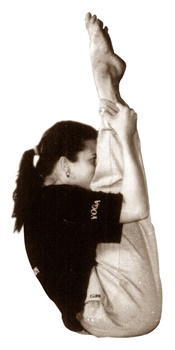
This asan is practiced, raising the legs, so it got its name.
Procedure:
1. Stretch both the legs straight. Raise the right leg up holding the right calf without bending the knee, breathing out try to place the head on the right knee. Breathing in slowly lower the leg back on the floor.
2. Repeat the same with the left leg.
3. Repeat the same with both the legs together. Holding the calves firmly, swing forward and backward.
4. Repeat the above keeping the legs apart.
Awareness:
Calf muscles
Advantages:
The nerves of the legs and the waist become strong.
“Padottanasan energizes the body from waist to toes”
23. Poorvottanasan:
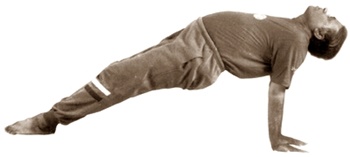
It is the reverse of Paschimottanasan.
Procedure:
Stretch both the legs straight and join them together. Place both the palms on the floor on the sides. Pressing the palms and the heels on the floor, breathing in, raise thighs, hips, stomach, chest, head and entire body. Bend the head loosely back. Breathing out bring the body slowly to the normal position. After repeating the exercise 5 to 6 times, being in the prime upper position turn the waist right and left 5 to 6 times.
Awareness:
Waist
Advantages:
Hands, shoulders, chest and waist become strong. Pains are relieved.
“Poorvottanasan cures the back and waist pain”
24. Nabhi darshanasan:
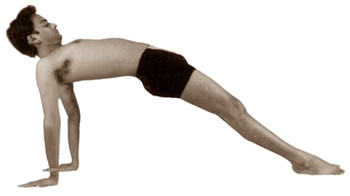
Nabhi (Navel) is looked at in this asan, so it got its name.
Procedure:
As in Poorvottanasan, pressing the floor with palms and the heels, breathing in, lift the thighs, hips, waist, stomach and chest. Bending the head forward towards chin, look at the navel. Breathing out come to normal position.
Awareness:
Navel
Advantages:
Hands, legs, waist and neck are strengthened. The power of navel increases.
“Nabhi darshanasan energizes the navel”
25. Sukhasan:
This asan is postured, sitting comfortably. So it is called Sukhasan. It is a very easy asan.
Procedure:
1. Sitting comfortably on the floor, bend the right leg and place it under the left knee and the left leg under the right knee. Neck, backbone and waist may be straight. Breathe normally.
2. Bend the knees as in above posture. Placing both the palms on the knees, the body is in a comfortably relaxed state. The body may be swung slightly forward and backward, as if fully immersed in a devotional song / music, breathing normally.
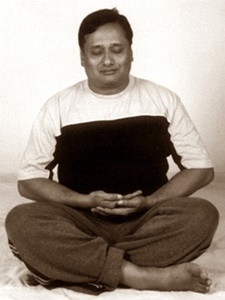
3. Fold both the legs raising the knees up. Tie a long cloth around the waist and the legs. One can relax in this posture conveniently. The breathing is normal.
The persons who have the habit of sitting in chairs may feel it difficult to sit down in folded leg position at the beginning. Gradually when they are used to it, they will feel it more comfortable.
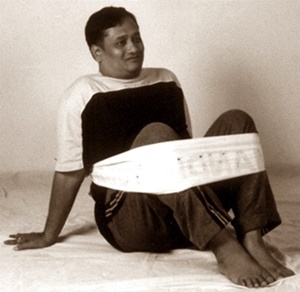
Awareness:
Breath / relaxation
Advantages:
One may sit for a long time comfortably in this asan. Therefore it is very useful for worshipping, meditating, chanting, tapasya…….and eating.
“Sukhasan is to relax in sitting position”
26. Siddhasan:
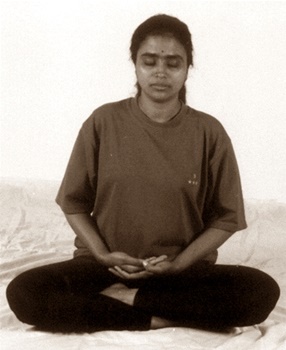
It is said that Siddhas and Yogis attained salvation by meditating, sitting in this asan. So it got its name. This is one of the four original and important Yogasanas.
Procedure:
Fold the legs across. Place the heel of one foot under the perineum and the other heel above the perineum. Place the toes of the upper foot between the other thigh and the calf. Keep the palms on the knees or one above the other. Keep backbone and the head in the straight position. Keep the eyes closed. At the beginning one may sit only for 3 to 4 minutes, but later it may be extended comfortably to maximum possible time. Relax by stretching the legs. In ancient times Yogis used to sit in this asan for hours together to concentrate and meditate. Bachelors, students, Yogis and saints have to practice this asan intensively and regularly for their development.
Awareness:
Lotus heart (the chest pit)
Advantages:
This asan prevents and cures heart diseases, breathing problems and indigestion. It controls semen discharge. Sex desire is controlled. Memory power is increased. Mind gets ready for meditation.
“Siddhasan helps to concentrate better”
27. Padmasan:

Padmasan is also one among the four important Yogasanas. The body in this posture looks like a Lotus (=Padma) so it got its name.
Yoga experts opine that as a lotus floats on water, grows in water, still it is not effected by water, so also the aspirant of Padmasan, though dwells in this world, is not effected by the worldly attractions. He or she is psychologically unattached and is above the ordinary worldly persons.
Procedure:
Place the right foot on the left thigh. Hold the knee and move it up and down. Later lifting the knee move the leg in a circular form. Repeat the same action by changing the knee. This is the preparatory stage for Padmasan.
Stretch both the legs. Place the left foot on the right thigh and the right one on the left thigh. This is Padmasan. Place both the palms on the knees open upward. Place the fore fingers on the thumb joints. The remaining three fingers of the each hand should be stretched straight downwards into Chinmudra.
The sight should be rested either in the center of the eyebrows or on the tip of the nose. The breath is normal.
Awareness:
Center of eyebrows / tip of nose / lotus heart (chest pit)
Note:
1. After the completion of Padmasan, slowly stretch the legs straight and later jerk them freely to relax.
2. The system of sitting on the floor is being given up these days. As a result legs and knees are becoming stiff and bending them is felt difficult. So some practitioners are unable to posture the Padmasan completely. In such cases Ardha-Padmasan is postured by placing one foot on the other thigh. The second foot is placed under the knee of the first foot. After practicing Ardha-Padmasan for few days, they may conveniently practice Padmasan.
Advantages:
Sitting for a long time without any movement in this asan makes one feel full of divine happiness. There would be no mental fatigue in this asan. Mind can be conveniently concentrated. The excess fat in the thighs is reduced. Heart, lungs and head are strengthened as the blood circulation in them is regulated through this asan. The sharpness of thinking is developed. This is the best asan for meditation and penance.
“Padmasan helps in the development of concentration”
28. Yogamudrasan:
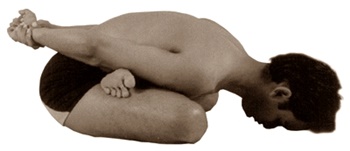
It symbolises many asans, so it is called Yogamudrasan.
Procedure:
Each of the following steps may be repeated 3 to 5 times.
1. Being in the Padmasan, lock both the hands at the back and stretch them. Breathing out bend forward so that the forehead touches the floor. Breathing in raise the body to the normal position. Buttocks should not raise.
Awareness:
Inside the head
2. Place both the palms on the abdomen and perform as in No.1 above
Awareness:
Navel
3. Stretch the arms upwards and perform as above
Awareness:
Arms
4. Stretch both the arms on both sides and perform as above
Awareness:
Chest
5. Place the palms behind the neck interlocking the fingers and perform as above.
Awareness:
Neck
6. Place both the hands on back holding one wrist with other hand. Perform as above raising the hands straight up.
Awareness:
Back
Advantages:
All the advantages of Padmasan and Shashankasan are derived from this asan. Diabetes and stomach diseases are controlled. The nerves in the thighs are strengthened. Anger is reduced and the mind becomes calm.
“Yogamudrasan eradicates stomach problems”
29. Parvatasan:
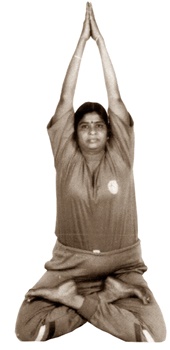
The body takes the shape of a mountain in this asan, it has got its name from that.
Procedure:
1. Sit in Padmasan. Raise the entire body on the knees. Raise the hands up into namaskar posture. Entire body is rested on the knees, maintaining the physical balance.
2. In advance stage, the practitioner walks forward on the knees balancing the body.
Awareness:
Knees
Advantages:
Apart from all benefits of Padmasan, knee pains are prevented.
“Parvatasan strengthens the knees”
30. Tulasan, Dolasan or Jhulasan:
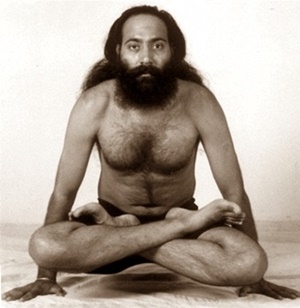
Tula means weighing scale. Both the shoulders take the shape of a scale in this asan. So it is also called Tulasan. The body in this asan swings like a cradle, so it is also called as Dolasan or Jhulasan.
Procedure:
Posturing Padmasan, place both the palms on the floor at the sides firmly. Raise the entire body, resting the weight of the body on the palms. Balancing on the palms swing forward and backward. Later bring the body down and massage both the hands.
Awareness:
Forearms
Advantages:
Apart from benefits of Padmasan, fingers, wrists, forearms and shoulders are strengthened. This is a very useful for desk workers, typists, computer operators and persons doing excessive physical work.
“Tulasan energizes every part of the arms”
31. Padma-konasan:
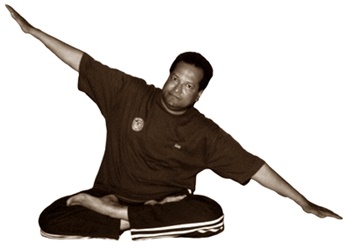
The body in Padmasan is bent to form an angle(=Kon). So it got this name.
Procedure:
Sitting in Padmasan, stretch both the hands sidewise, palms facing downwards. Breathing out bend the body to right holding for few seconds. Breathing in bring it to normal position. In the same way bend to left. Repeat it 4 to 6 times in alternate directions.
Awareness:
Alternate sides of waist
Advantages:
Apart from all the benefits of Padmasan, the excess fat in the waist is reduced. It also relieves the waist pain.
“Padma-konasan reduces the excess fat in the waist”
32. Padma chakrasan:
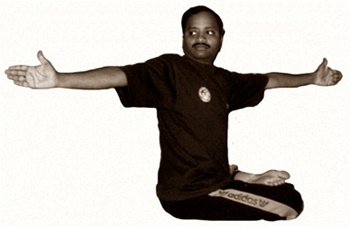
Being in the Padmasan, the waist and backbone are twisted. Hence it got this name.
Procedure:
Sit in Padmasan. Keeping the backbone straight, stretch both the hands sidewise with thumbs up. Breathing out turn the body to right and look back. Breathing in, bring the body back to normal position. Similarly, turn towards left and repeat the exercise. Repeat the same 4 to 6 times alternately.
Awareness:
Backbone
Advantages:
Apart from all the benefits of Padmasan, the pain in the backbone is relieved. The backbone becomes flexible and supple. This is very useful for those who sit for long hours to write or to type or at computer etc.
“Padma chakrasan makes the backbone flexible”
33. Kukkutasan:
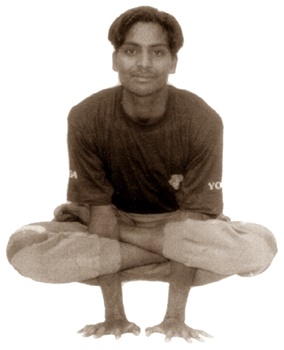
Kukkut means cock. The body takes the shape of a cock in this asan.
Procedure:
Posturing Padmasan, insert both the palms from near under the knees and place them on the floor with spread fingers. Resting the entire weight of the body on the palms slowly lift the body up. Maintain the balance.
You may be in this posture as long as possible. Breathing is normal. Gradually bring the body down to the floor. Take out the hands and massage them. Later deposturing the Padmasan relax.
Before attempting this asan, hands, thighs and calves are to be gently massaged with oil. This asan being a difficult one, should be practiced with utmost care, under supervision.
Awareness:
Forearms / wrists / palms
Advantages:
All the advantages of Padamsan are derived from this asan. Digestive power increases. Nerves are stimulated. Wrists, elbows, shoulders and chest are energized. This asan helps to preserve ‘The Youth’.
“Kukkutasan increases internal strength”
34. Garbhasan:
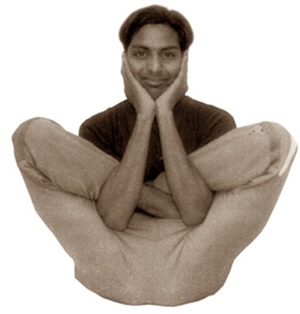
Garbh means womb. The posture in this asan resembles the shape of a fetus in the womb.
Procedure:
Posturing Kukkutasan, move the elbows further forward. Rest the entire weight of the body on the buttocks. Place both the palms on the cheeks joining both the bottoms of the palms together. Maintain the balance of the body. Breath is normal. Deposture the Garbhasan slowly and come to normal position. Massage hands and legs thoroughly. It is difficult one, so this should be practiced STRICTLY under the guidance of a Yoga expert.
Awareness:
The entire body
Advantages:
Apart from the benefits of Padmasan and Kukkutasan, calves, thighs and buttocks are strengthened. It benefits a lot for people suffering from hernia. Diseases of urinary organs are cured. Menstruation problems are solved. The body becomes slim and trim.
Prohibition:
People with over-weight should not attempt this by force.
“Garbhasan makes the body attractive”
35. Baddha Padmasan:
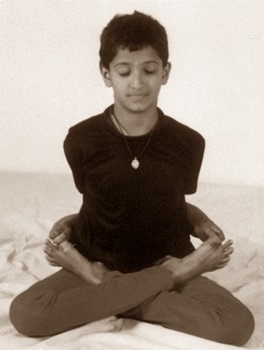
Both the hands are tied up in this asan.
Procedure:
Posture Padmasana, take both the hands back. Hold the right toes with the left hand and the left toes by right hand. Both the hands are crossed at the back. Be in this posture as long as possible. Later release the toes and bring the hands to the normal position from the back. Deposture the Padmasan. Massage hands and legs and relax.
Note: Initially, if one finds difficult to hold the toes, pieces of cloth may be tied to toes and held.
Awareness:
Heart
Advantages:
Apart from benefits of Padmasan, blood pressure is normalized and heart is energized. Back pain and sciatica pains are relieved. Blood circulation is properly regulated. Breasts of women are strengthened and more quantity of milk is produced in feeding mothers.
“Baddha Padmasan normalizes the blood pressure”
36. Matsyasan:
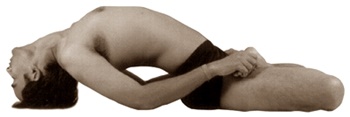
Body takes the shape of a fish (=matsya) in this posture.
Procedure:
Sit in Padmasan. Slowly place the elbows on the floor, gradually bending the body backward, place the head on the floor. Hold the toes of both the legs with both the hands, so that the raised backbone forms an arch. Breathing is normal.
Note: Those who cannot posture Padmasan, may do it by stretching the legs straight.
Awareness:
Back
Advantages:
Spondylitis, neck pain and breathing problems are cured. It releases the gases from the body and keeps the stomach clean. Lungs are purified and energized.
“Matsyasan energizes the neck and chest”
37. Bakasan:
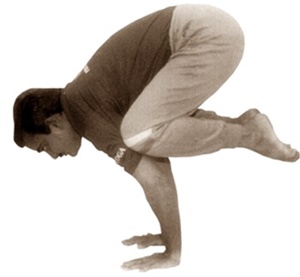
Bak means crane. The body takes the shape of a crane in this posture. It is a difficult asan.
Procedure:
Sitting in Vajrasan, place both the palms, knees and toes on the floor. Pressing the palms on the floor, raise both the knees and place them near elbows. Later balancing the body, raise the feet too. Entire body rests on the palms alone. After being in this posture for some time, slowly bring down the legs on the floor and the body into Vajrasan. Massage the hands and relax. Breathing is normal.
Awareness:
Wrists / arms
Advantages:
The nerves and the muscles in hand, waist and shoulder become strong. This helps in developing balanced thinking.
Prohibition:
People with weak hands should not attempt this asan. Fat people should attempt it with great care.
“Bakasan strengthens the muscles of the arms”
38. Padangushthasan:
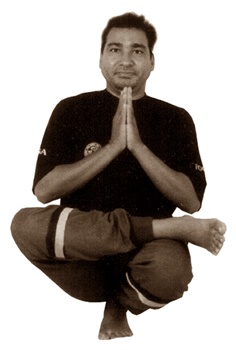
The entire body rests on the toes, in this asan.
Procedure:
Sit on toes keeping both the palms on the floor. Raise the right leg and place on the left thigh. Adjusting the balance of the body on the left toes bring both the hands (a) near the chest and fold into namaskar mudra then (b) raise both the hands up straight and join into namaskar mudra.
Stay in this posture as long as possible.
Repeat the same changing the legs. Breathing is normal.
Awareness:
The balance of the body
Advantages:
Toes, calves, ankles and thighs are strengthened. The body is always in its correct balance.
“Padangushthasan is for the balance of the body and mind”
39. Aakarna Dhanurasan:
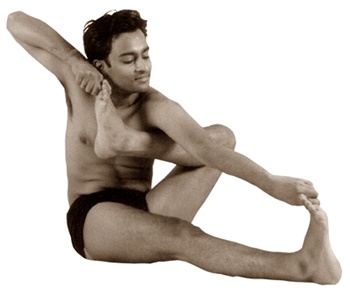
The body in this posture takes the shape of a bow with an arrow ready to be shot.
Procedure:
Stretch both the legs straight. Place the right leg on the left leg across. Hold the right toe by the left hand. Similarly the left toe is held by the right hand. Breathing out bending at knee, lift the right leg up, so that the right toe touches the left ear. Then straighten the leg breathing in. Repeat 5 to 6 times.
Then repeat changing the legs.
Note: If it is felt difficult to lift the leg with one hand, both the hands may be used to lift the leg.
Awareness:
Knees / thought of the victory on inner enemies
Advantages:
This is very beneficial to the persons, who sit and work in the offices for a long time. The nerves and muscles of hands, legs, waist and shoulders become strong and they function actively. Knee troubles are solved. The great internal enemies such as kama, krodha, lobha, mada, moha, matsarya can be easily conquered through regular practice of this asan.
“Aakarn Dhanurasan conquers the internal enemies”
40. Koormasan:
Koorma means tortoise. The body in this posture resembles a tortoise.
Procedure:
1. Stretch both the legs straight. Raise both the knees up spreading on the sides. Then pass both the hands under the knees. Placing the forehead on the floor stay for a while, with slow breathing.
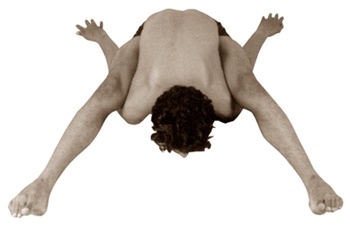
2. From the above position take the hands back around the waist and join the heels. Breathing out, let the forehead touch the floor between the legs. Being in the same position for some time deposture to normal position and relax.

Awareness:
Abdomen
Advantages:
Stomach diseases are cured. Pot-belly is reduced. The life span increases like the life of a tortoise.
“Koormasan reduces the bulginess of the stomach”
41. Simhasan:
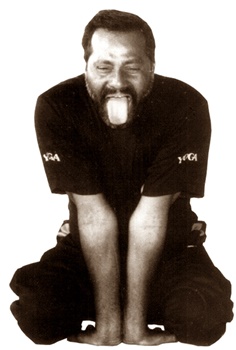
Simhasan is one of the four important Yogasans. The body in this asan is to be postured like a roaring lion.
Procedure:
In Vajrasan, place both the palms on the floor, from inside the knees. Bend the chest and waist raising the head. Tongue is stretched out. After taking a deep breath exhale the breath with great forceful roaring like a lion.
After roaring three to four times, come to normal position. This exercise should not be overdone.
It is a difficult asan. There are five stages in it. Posturing stage after stage finally enter into Simhasan at the 5th stage.
Note:
1. In all the 5 stages, sight is focused on the tip of the nose continuously.
2. In all the 5 stages, mouth is wide open keeping maximum gap between two lips.
Stage – 1:
Posturing the Vajrasan or Sukhasan, place both the palms on thighs. Hold the breath and contract the tongue inside the mouth. After about five seconds, relax. Repeat 3 times.
Stage – 2:
Performing as in stage 1, tilt the tongue upwards – retroflexed and try to touch the small inner tongue inside with the tip of the tongue. Repeat thrice.
Stage – 3:
Performing as in ‘stage 1, stretch the tongue out to its maximum trying to touch the chin with the tip of the tongue. Repeat thrice.
Stage – 4:
Sit in Vajrasan and place both the palms on the floor between the knees, fingers pointing backwards. After inhaling through nose, now stretching the tongue out to its maximum, trying to touch the chin, breathe out through mouth with a deep hissing sound coming out of the throat. Repeat thrice.
Stage – 5:
Perform as in stage 4, but after inhaling once through nose, breathe out with a loud roaring sound of a lion coming out of throat in three strokes, the last of which should be as long as possible.
After the above five stages are performed three to four times, massage both the wrists and hands. The throat gets dried up in this asan. Therefore soon after this asan, Sheetali and Seetkari Pranayaams (refer chapter No. 18) are to be practiced without fail.
Awareness:
Eyes / Ears / Nose / Throat / Face / Brain
Advantages:
Ear, nose, throat, eyes, brain and chest are purified and energized. Hearing and breathing problems are controlled. Eyes can see better. Throat is cleansed. Voice improves. Face becomes glittering and eyes get a sparkle in them. Memory, concentration and will power develop. The central nervous system is recharged with energy.
“Simhasan cleans the nerves from throat to brain”
42. Mayurasan:
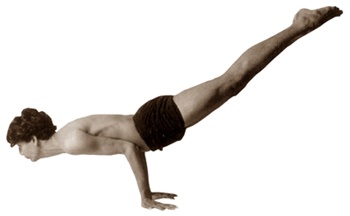
The posture in this asan resembles like a peacock (=mayur). This is a difficult asan.
Procedure:
Sitting in Vajrasan, rest the palms on the floor, in front of the knees with fingers pointing towards the knees. Slowly raising the waist up, balancing the entire weight of body on the palms, abdomen resting on the elbows, raise the legs stretching backwards in the shape of a peacock. Keep the head little up, breathing normally. After some time bring the knees down on the floor, come back to Vajrasan, then massage the forearms and relax with deep breathing.
Awareness:
Navel
Advantages:
Stomach and intestines are strengthened. Digestive power is enhanced. Stomach is made free from bacterial infections. Diabetes is controlled. Obesity of the body is reduced. Wrists and shoulders are strengthened.
According to shashtras, it is said that the regular practitioner of Mayurasan, can even digest the poison easily.
Prohibition:
People suffering from ulcer, hernia, heart diseases or general weakness and with weak hands and pregnants are advised not to try this asan. Some experts opine that women should not attempt this asan at all.
“Mayurasan strengthens the hands and digestive organs”
43. Mayuri asan:
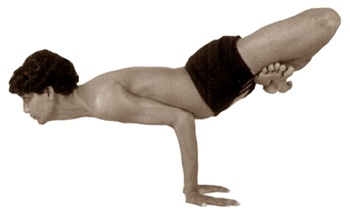
Mayuri means peahen. It is similar to Mayurasan.
Procedure:
Starting at Padmasan (instead of Vajrasan) perform Mayurasan as above. The legs are stretched straight in Mayurasan. In Mayuri asan the legs are folded into Padmasan.
Awareness:
Navel
Advantages:
All the benefits of Mayurasan and Padmasan are derived from this asan.
Prohibition:
All the prohibitions of Mayurasan and Padmasan are applicable to this asan also.
“Mayuri asan strengthens the hands, legs and digestive organs”
![]()
After the completion of posturing the sitting asanas, preferably in above referred sequence, Balasan (one of the exercises postured lying on back) should be practiced for relaxing the limbs. Finally complete rest should be taken in first in Nispand-bhavasan and then Shanti asan for some time, so that the energy generated out of the above practice is properly distributed all over the body.
Most of the above asanas, postured in sitting position are easy and few are difficult. The easy ones can be practiced by the practitioners on their own accord, but the difficult ones are to be practiced under the guidance of Yoga experts.
![]()
